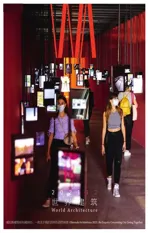城市实践的实例
2021-12-24策展人raumlaborberlin
策展人: raumlaborberlin

1 展览装置/Exhibition installations(摄影/Photo: Nils Koenning)
“城市实践的实例”是关于如何转移建筑学的视角:从建筑对象到建筑实践,从事物或最终结果到合格的过程——把建筑看作一系列具有社会立场的行动。
通过“城市实践的实例”,raumlabor展示了两个环境,它们目前正在现场谈判的过程中,raumlabor在一个由各种合作者组成的网络中担任着发起人、谈判者、空间创造者、调解者和照看者的角色。
“漂浮大学”和“统计局大楼”都位于柏林,相邻地区都很特别:“漂浮大学”毗邻前坦佩尔霍夫机场,“统计局大楼”在亚历山大广场附近。它们有非常不同的特点和外观,但都以同一种哲学为基础。两者都起源于一种艺术主张和倡议,并发展成为复杂的自我组织形式和公共—公民或科学—艺术—公民合作形式。我们喜欢把它们看作是学习空间,其意义在于如何重新学习另一种城市建设的方式,即意识到我们未来面临的紧迫问题:我们与地球的关系以及城市的权利问题。这包括考虑到获得知识的动态过程,应对空间和社会形式演变的方式。
我们在军械库的装置由一个脚手架结构和一个气泡室组成,参考了2018年的“漂浮大学”。在展览中,脚手架成为展示两个项目的图片和图形的框架:一面是“漂浮”的故事,另一面则是“统计局大楼”的内容。每面的主要图片是一条时间线,它显示了合作、网络和主要事件,从而为装置上面的快照提供了一个背景。
我们的装置展示了两种合作方式的例子,以创造实验和探索的共同空间,走向未知的未来。这两个项目的开放性允许个人和团体根据自己的条件加入和参与,用他们的观点和专业知识丰富集体领域。这两个项目都在向非学科环境演变,挑战来自各领域的经验,以找到将他们的知识转化为持续动态过程的模式。这两个项目为支持新兴社区共同创造未来城市提供了多样的形式。
至于在新兴社区,“我们将如何共同生活”的问题,我们相信这要通过将建筑这门学科扩展到当代社会领域来回答。通过集体的努力来创造一个更好的城市。通过成为社区的一部分,在对话中提出共同的、可能的未来,并与现场不断变化的情况产生共鸣。通过理解和参与城市转型,解读权力结构,理解多方利益相关者的利益驱动,并将自己的议程置于其中。我们相信城市实践者不能保持中立,通过参与,实践者可能成为未来的复杂领域的导航者。
raumlabor在威尼斯双年展的第17届建筑展“我们将如何生活在一起?”中被授予了金狮奖,因为它“以一种鼓舞人心的合作方式,主张参与、再生和集体责任,使两个项目成为富有想象力的城市振兴的典范”。□(钱芳 译)
Instances of Urban Practice is about shifting the perspective in architecture: from the built object to architectural practice, from thing or final outcome to a qualified process - architecture as a series of actions that takes a societal position.
With Instances of Urban Practice, raumlabor presents two environments that are currently in the process of being negotiated on site, where raumlabor is involved within a diverse network of collaborators as initiator, negotiator, space-creator, mediator and caretaker. The Floating University and Haus der Statistik.
Both are located in Berlin, adjacent to outstanding places: Floating University neighbouring the former Tempelhof airport, and Haus der Statistik just off Alexanderplatz. They have very different characteristics and physical appearances but are both built on the same philosophy. Both share their origin in an artistic claim and initiative, growing into complex forms of self-organisation and publiccivic or scientific-artistic-civic cooperation. We love to see them as learning spaces. Learning in the sense of how to re-learn another way of city-making, that is aware of the pressing questions of our tomorrows: our relationship as humans to the planetary dimension and the question of the right to the city. This includes taking care of dynamic processes of acquiring knowledge, adopting, and reacting towards the evolution of the spatial and social forms.
Our installation in Arsenale consists of a scaffolding structure and a bubble room, referencing the architecture of the Floating University in 2018. In the exhibit, the scaffolding becomes the frame for pictures and graphics from both contexts: one side tells the story of the Floating, the other side that of the Haus der Statistik. The key graphic on each side is a timeline, that shows the cooperation, networks and events and thus gives the snapshots above in the installation a context.
Our installation shows two examples of collaborative approaches to create common spaces of experimentation and exploration towards unknown futures. The openness of both projects allows for individuals and groups to join and engage on their own terms, enriching the collective sphere with their perspectives and expertise. Both are evolving into non-disciplinary environments, challenging experience from all fields to find modes of translating their knowledge into the ongoing dynamics of the process. Both projects offer complex forms for supporting emerging communities to cocreate the future city.
Responding to the question "how will we live together?" in emerging communities, we believe it is through extending architecture as a discipline into fields of contemporary societal struggles. By taking collective efforts in making a better city. By being part of a community where proposals for common possible futures are developed in dialogue and in resonance with the evolving situation on site. By understanding and engaging with urban transformation, reading power structures, understanding the driving interests of a multiplicity of stakeholders and placing an own agenda within that. We believe the urban practitioner cannot stay neutral. By getting involved the practitioner becomes a navigator of complex fields of possible futures.
raumlabor has been awarded the Golden Lion in the 17th architecture exhibition "how will we live together?" in the Venice Biennale, for "an inspiring collaborative approach that argues for participation, regeneration and collective responsibility, resulting in two projects that are a model for imaginative civic revitalisation". □

2 漂浮大学/Floating University(摄影/Photo: Victoria Tomaschko)

3 统计局大楼/Haus der Statistik(图片来源/Image courtesy: ©ZKB)

7 气泡屋/The bubble room(图片来源/Image courtesy: raumlaborberlin)
项目信息/Credits and Data
设计团队/Design Team: Andrea Hofmann, Axel Timm, Benjamin Foerster-Baldenius, Christof Mayer, Florian Stirnemann, Francesco Apuzzo, Frauke Gerstenberg, Jan Liesegang, Markus Bader
合作团队/Collaboration Team: Anna Foerster-Baldenius, Claire Mothais, Luka Murovec
气泡装置团队/Bubble Team: Ágnes László, Alice Baseian, Theo Göken
项目合作/Project Partners: Floating University - floating e.V.; Haus der Statistik - ZUsammenKUNFT Berlin e.G.
施工团队/Construction Team: Franz Siebler, Louise Nguyen, Olof Duus, Victor Navarro项目时间/Time: 2021.05.23-2021.11.21
合作方/Collaborator: Kulturprojekte Berlin
支持方/Supporter: ifa - Institut für Auslandsbeziehungen

8 气泡屋/The bubble room(摄影/Photo: Andrea Avezzù)
